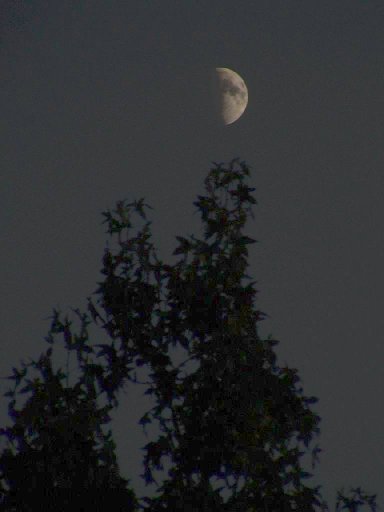

The Moon is the Earth only large satellite. The others are much smaller satellites, especially human satellites, that in general are not visible. I'm pretty sure there are some other natural satellites, but none are known.
I'm writing this page for one main reason: there are many people out there who, once in a while, ask why our Moon does not have name. Thus, I really needed to write a page to give the answer to these people!
The Solar System is composed of many objects. The primary objects are the Sun our star and the planets: Mercury, Venus, Earth, Mars, Jupiter, Saturn, Uranus and Neptune. We have two different types of planets in our Solar System. The rocky planets like Earth and the large gaseous planets like Jupiter. All our Planets turn around the Sun in a near perfect circle. And they nearly all are in the same plane.
All the planets have other caracteristics common to each others. They all turn on themselves and all those with gas have weather conditions similar to those observed on Earth such as storms.
One more caracteristic common to most planets: they have objects turning around them. This is similar, in a way, to the planets turning around the Sun. These objects are most often called moons.
This is where I come in. The Moon is the Earth satellite. The other objects should not be called moons, they are satellites.
And yes: the electronic devices that humans send around the Earth are also called satellite; more specifically, artificial satellites. When one of our ships turns around Mars, it is called a satellite too. Most people will refer to those by their name like Galileo I or Viking 4 (noticed the error here?)
The interesting aspect of this problem mainly happens in the English language. At least, when I was young living in France, the Moon (Lune) was the Earth satellite and all the other satellites where properly called satellites. I thought it was important to mention that since it is not everyone who name things the wrong way.
Thus, the name Moon, in English, is the name of the Moon. Period. (As a side note, in Dutch it is Maan, and in German Mund.)
It seems that the word "moon" (non capitalized) can still be used to say "natural satellite". I just wonder why we try to make this complicated since when we talk we cannot hear the capitalization... (at least, me, I cannot...)
Also, some people tend to capitalized the 't' in "The Moon". That's a Tarot card, not a satellite. So unless at the beginning of a sentence, do not capitalize the article.
Note that in English, you say "lunar" for something that refer to the moon (i.e. the adjective form is the latin word!) For instance, Lunar Landing or Lunar Exploration.
Romans called the Moon Luna, which is still used in Italy. A few artificial satellites have been named Luna by Russian (the Russian word for Moon is Luna written Луна in cyrillic.)
| Language | Moon |
|---|---|
| Arabic | ﺳﻮرة اﻟﻘﻤﺮ (i.e. Surat Al-Qamar) |
| Dutch | Mund |
| French | Lune |
| German | Mund |
| Greek | Φεγγαρι (i.e. fengári/pheggari) |
| Italian | Luna |
| Portuguese | Lua |
| Russian | Луна (i.e. Luna) |
| Spanish | Luna |
Old Greek people would call the Moon Σελήυη (Selene), the titaness of the Moon, daughter of Hyperion and Theia. The goddess of the forests and the hills, 'Άρτεμιϛ (Artemis), is the daughter of Zeus and Leto. She has been associated with the Moon, but does not seem to be a replacement to Σελήυη.
The words month and Monday in English (Monat and Montag in German) come from the word Moon.
Did you notice that the Moon always looks the same? That's because we always see the same side. The Moon does not rotate on itself!
Perigee ...................... 363,104 km (0.0024 AU)
Apogee ....................... 405,696 km (0.0027 AU)
Semi-major axis .............. 384,399 km (0.00257 AU)
Eccentricity ................. 0.0549
Orbital period ............... 27.321582 d (27 d 7 h 43.1 min)
Synodic period ............... 29.530588 d (29 d 12 h 44.0 min)
Average orbital speed ........ 1.022 km/s
Inclination .................. 5.145° to the ecliptic
(between 18.29° and 28.58° to Earth's equator)
Longitude of ascending node .. regressing by one revolution in 18.6 years
Argument of perigee .......... progressing by one revolution in 8.85 years
Satellite of ................. Earth
Mean radius .................. 1,737.10 km (0.273 Earths)
Equatorial radius ............ 1,738.14 km (0.273 Earths)
Polar radius ................. 1,735.97 km (0.273 Earths)
Flattening ................... 0.00125
Circumference ................ 10,921 km (equatorial)
Surface area ................. 3.793×107 km² (0.074 Earths)
Volume ....................... 2.1958×1010 km³ (0.020 Earths)
Mass ......................... 7.3477×1022 kg (0.0123 Earths)
Mean density ................. 3,346.4 kg/m³
Equatorial surface gravity ... 1.622 m/s² (0.1654 g)
Escape velocity .............. 2.38 km/s
Sidereal rotation period ..... 27.321582 d (synchronous)
Equatorial rotation velocity . 4.627 m/s
Axial tilt ................... 1.5424° (to ecliptic)
6.687° (to orbit plane)
Albedo ....................... 0.12
Surface temp. min mean max
equator 100 K 220 K 390 K
85°N 70 K 130 K 230 K
Apparent magnitude ........... -2.5 to -12.9
-12.74 (mean full moon)
Angular diameter ............. 29.3 to 34.1 arcminutes
Adjectives ................... "lunar"